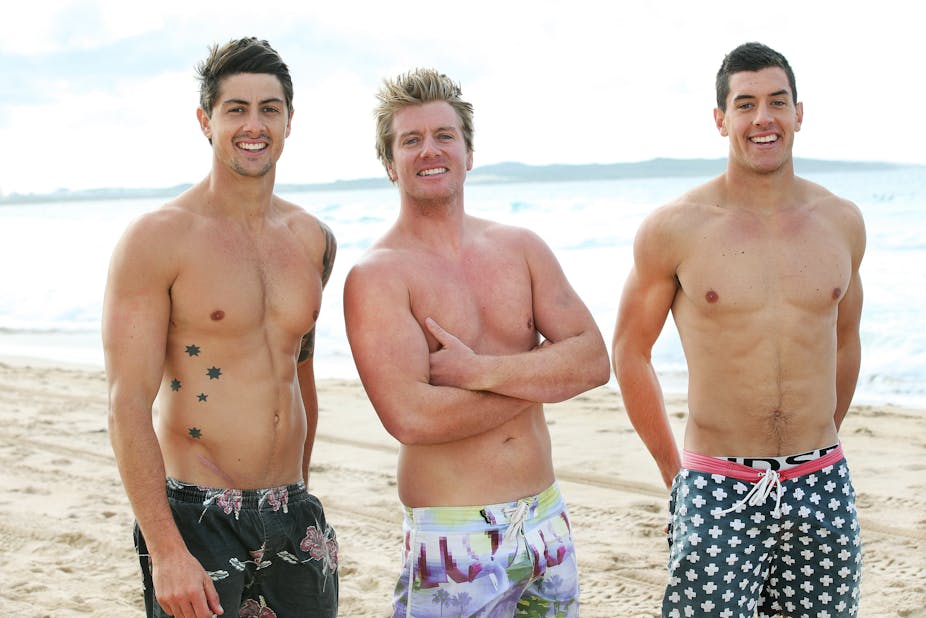The first episode of The Shire ran last night on Channel 10. Described as “dramality” – a combination of drama and reality television – the show purports to show the lives of young people living in Sutherland Shire, known colloquially as “The Shire”.
But why is this place, south of Sydney, the chosen setting for this kind of program? And what can this setting, and the show overall, tell us about the kind of Australia that is projected?
A little piece of paradise?
Sutherland Shire sees itself, in its own marketing, as a “natural oasis” protected from the urban life of Sydney. This is what the show trades on – the idea of the shire as a utopian space, a place where young people live special lives cut off from normality. The Shire expresses this claim to utopian exceptionality.
Shot using the kinds of production values typical of American shows such as CSI: Miami, The Shire offers us a glossy, hyper-real, hyper-colourful Australia.
It is no coincidence that it is the same setting for the first big Australian reality show, [Sylvania Waters](http://en.wikipedia.org/wiki/Sylvania_Waters_(TV_series). The fly-on-the-wall series about the blended families of Noelene Baker and Laurie Donaher was broadcast on Australian television in 1992 (and in Britain in 1993).
Then, as now with this new reality show, it was trying to show a particular image of Australia – something that may have been embarrassing but only to those that lived outside its borders.
In Sylvania Waters, many viewers saw the Baker-Donaher clan as the appalling nouveau riche. But what was shocking in 1992 has become, it seems, enviable in 2012. The difference is eleven years of John Howard’s neoliberal agenda. Between the two series only the attitude has changed. The McMansions of the Shire could well have been the waterside home of the Baker-Donahers.
The projected image of this life in this setting is a particular view of Australia that we have come to accept as normal – the beach, the sand and conservative values. A kind of Eden that many might aspire to.
Faking it
This version of Australia hasn’t changed since Sylvania Waters, and neither has the narrative framework in which our semi-fictional, semi-real characters operate. How race and youth are treated in the show are particularly telling.
Sophie and her best friend Vernesa are two characters in The Shire. Sophie works as a beautician and they see nothing wrong in focusing on and enhancing their natural attributes, fake lips and forehead go with fake tan and fake breasts. As Howard’s neoliberal social philosophy demanded, they are self-made. The obsession here is with youth – all that is needed is a stray grey hair and the characters go running to get botox.
Bekaa too, another character, returns from Dubai where she has had a nose job. For these women cosmetic surgery is a key aspect of the kind of individualised self-help they identify with. Their remade bodies blend with the remaking of life-styles that are exemplified in those in The Shire.
The more things change…
Sophie and Vernesa are non-anglo characters and their given roles mark them as distinct from the main group. They are not present at Rif Raf’s party. The new “dramality” format does not mean viewers will be getting a new kind of narrative with non-anglo characters on an equal footing.
In fact, the “Aussie” characters i, Mitch, Gabby, Andy, Bekaa, and the rest, could be straight out of Home and Away. Like Home and Away, and Australian soap operas generally, ethnic characters are kept to a minimum and when they do appear are still often given secondary roles.
While this is problematic enough in soap operas, in a “dramality” like The Shire, which claims some degree of realistic representation, it is even more pernicious.
After all, this is where the 2005 Cronulla riots took place. Then, Lebanese people who were coming in by train to use the beach were seen as a threat to the locals’ way of life. They weren’t Aussie enough. From this perspective, the Cronulla riots took place where they did for the same reason that both Sylvania Waters and The Shire were shot there: the shire gets thought of as a utopian repository of Aussie values.
The character of rapper Rif Raf and his family, most likely of Lebanese descent, seem to have learnt the lesson. If you want to be accepted you have to assimilate, and the best way to do that is through upward social mobility into a nouveau riche life of spectacular consumption.
The same might be said for Sophie and Vernesa. For whom are they going through all the trouble of remaking their bodies? Perhaps for themselves, but also to be of more value in the dating market.
In this shire, this utopia of Aussie values, what is acceptable is founded in the hyper-real glossiness and then expressed through the late capitalist remaking of everyday life as consumerist spectacle.
What is missing of course, is any true portrait of Australia. But perhaps, in the end, a real Australia would be too confronting, at least to those with traditional Aussie values.

